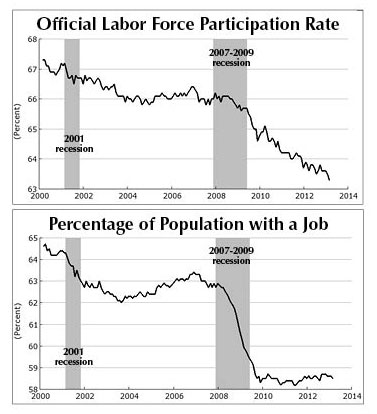

Vol. 77/No. 15 April 22, 2013

|
| In recent years U.S. Labor Department has removed millions of workers who want a job from official labor force figure (top graph). This, not more jobs, accounts for decline in unemployment rate since end of last recession. Proof is fact that percentage of population with a job has remained at low level for nearly past four years (bottom). Some articles in big-business press have been pushing “theory” that declining “participation” in labor force is, at least in part, due to increasing numbers of workers who prefer instead to collect government disability benefits. |
An article in the April 7 edition of the Wall Street Journal titled “Workers Stuck in Disability Stunt Economic Recovery” is an example of the latter. The front-page piece by Leslie Scism and Jon Hilsenrath presents a “theory” that amounts to little more than yet another pretext to go after social protections workers have won in struggle and an ideological assault on working-class solidarity.
“Signs of the problem surfaced Friday, in a dismal jobs report that showed the U.S. labor force participation rate falling last month to the lowest levels since 1979, the wrong direction for an economy that instead needs new legions of working men and women to drive growth,” the article said.
The labor force is the section of the population that the government counts as either working or looking for work and is used by Labor Department statisticians to calculate the official unemployment rate. Each month the department’s Bureau of Labor Statistics has been removing thousands of so-called discouraged workers from the official labor force figures. As a result, the unemployment rate has declined, while the percentage of the population with a job has remained at the same low level for nearly four years straight.
For example, in March the Department of Labor reported a drop in the unemployment rate from 7.7 to 7.6 percent. But this slight dip is not because more workers got jobs, but because the government excluded from the workforce count nearly half a million workers.
According to the Department of Labor, there are about 6.4 million workers not counted as part of the labor force “who currently want a job.”
But according to Scism and Hilsenrath, the employment crisis results from too many workers declining to “participate” in the labor force. A substantial reason for this, we are to believe, is because of the laziness of millions who opt to receive federal disability benefits instead of looking for a job.
The article cites an “expert,” Michael Feroli, chief U.S. economist for J.P. Morgan, who “estimates that since the recession, the worker flight to the Social Security Disability Insurance program accounts for as much as a quarter of the puzzling drop in participation rates, a labor exodus with far-reaching consequences.”
High joblessness and large numbers of long-term unemployed over time do result in a smaller workforce. The “puzzling” problem, we are told, is not that bosses aren’t hiring or the result of a worldwide slowdown in capitalist production and trade, but because of rising ranks of deadbeats. Increasing on-the-job injuries from speedup and other productivity schemes are not even mentioned as possible factors.
This idea is getting an echo in other capitalist papers. “It took a while, but a great many of those folks finally figured out there was another scam to be had — social security disability,” wrote Joe Klein in a April 9 piece published in Time magazine.
Meanwhile, the labor participation rate of men age 20 and over was 72.7 percent in March, matching the low of August 2012, the lowest level since such records began being kept in 1948.
Workers under age 25 account for nearly half of those “dropped” from the workforce last month. The youth unemployment rate is actually 22.9 percent, stated the Journal, if you include the 1.8 million young workers removed from the official workforce since December 2007.
Nearly 40 percent of those unemployed have been out of work for six months or more, according to the Labor Department. And large numbers of workers getting jobs are forced into part-time hours or “temp” work at lower pay.
Front page (for this issue) |
Home |
Text-version home